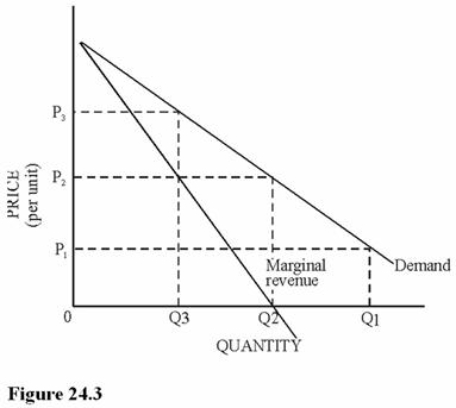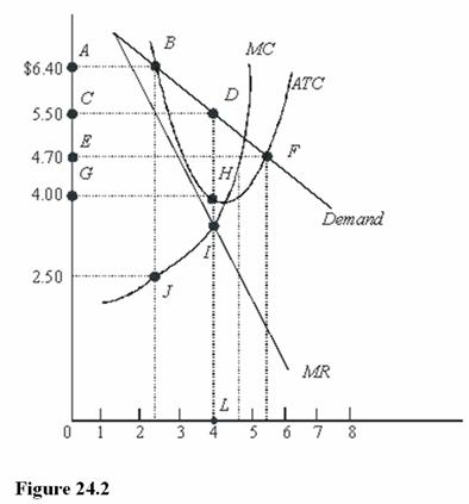A) Market power increases incentives for innovation and invention.
B) Market power results in lower barriers to entry.
C) The exercise of market power results in a higher price.
D) Large firms can produce more efficiently than small firms because of diminishing returns in production.Economies of scale may help monopolies reduce costs, but because of their market power, they will retain the cost savings rather than pass them along to the consumer in the form of lower prices.
Correct Answer

verified
Correct Answer
verified
Multiple Choice
A monopolist that does not practice price discrimination should never produce in the
A) Elastic portion of its demand curve because it can increase total revenue and reduce total costs by lowering the price.
B) Inelastic portion of its demand curve because it can increase total revenue and reduce total costs by increasing the price.
C) Inelastic portion of its demand curve because it can increase total revenue by more than it increases total cost by reducing the price.
D) Segment of its demand curve where the price elasticity of demand is greater than 1.
Correct Answer

verified
Correct Answer
verified
Multiple Choice
Which of the following rules is satisfied when a monopoly maximizes profits?
A) Price = AVC.
B) Price < MC.
C) MR = MC.
D) MR > MC.
Correct Answer

verified
Correct Answer
verified
True/False
Monopolists have an advantage over competitive markets in receiving the full benefit of research and development efforts.
Correct Answer

verified
True
Correct Answer
verified
True/False
A multi-plant monopolist produces more than if each of its plants were a separate firm in a competitive market.
Correct Answer

verified
Correct Answer
verified
Multiple Choice
If tourists are charged a much higher price than the natives of a country for exactly the same item, what kind of pricing is involved?
A) Monopoly pricing.
B) Price discrimination.
C) Competitive pricing.
D) MC = MR pricing.
Correct Answer

verified
Correct Answer
verified
Multiple Choice
 Refer to Figure 24.3.Suppose this good could somehow be produced at no cost (that is, the total cost at any level of output was zero) .This single-price monopoly firm would maximize profit by
Refer to Figure 24.3.Suppose this good could somehow be produced at no cost (that is, the total cost at any level of output was zero) .This single-price monopoly firm would maximize profit by
A) Raising the price as high as possible until the quantity demanded began to decrease.
B) Producing an infinite amount and selling at the highest price possible.
C) Producing Q2 and charging P2.
D) Producing Q3 and charging P3.
Correct Answer

verified
Correct Answer
verified
Multiple Choice
 In Figure 24.2, a profit-maximizing monopolist will charge a price of
In Figure 24.2, a profit-maximizing monopolist will charge a price of
A) $6.40.
B) $4.70.
C) $4.00.
D) $5.50.
Correct Answer

verified
Correct Answer
verified
Multiple Choice
In Table 24.1, according to the profit maximization rule, at the profit-maximizing level of output, total cost is
A) $900.
B) $1,200.
C) $650.
D) $950.
Correct Answer

verified
Correct Answer
verified
Multiple Choice
Consumers may not experience the benefits of economies of scale because a natural monopoly
A) Has higher costs with higher output.
B) Engages in marginal cost pricing.
C) Increases output beyond efficient levels.
D) Charges prices higher than competitive levels.
Correct Answer

verified
Correct Answer
verified
Multiple Choice
Google is currently being investigated by
A) The European Antitrust Authority.
B) The U.S.Justice Department.
C) Intel corporation.
D) The FTC.
Correct Answer

verified
Correct Answer
verified
Multiple Choice
All of the following are limitations on the market power of a monopoly except
A) The elasticity of demand.
B) The inability of a firm to control demand.
C) The ability of a company to control the quantity supplied.
D) The demand curve.
Correct Answer

verified
Correct Answer
verified
Multiple Choice
Which of the following is likely to be a monopolist?
A) A drug firm that has a patent granting it the exclusive right to produce a drug.
B) A large firm like GM, which has a substantial portion of the car market.
C) The Boeing Company, which is one of the largest producers of airplanes.
D) An Indonesian restaurant in a large city.
Correct Answer

verified
Correct Answer
verified
Multiple Choice
Google holds market power by all of the following strategies except
A) Purchasing rivals.
B) Low pricing.
C) Exclusive dealings with advertisers.
D) Elimination of search results for competitors.
Correct Answer

verified
Correct Answer
verified
True/False
It is possible for a monopolist to earn an economic loss.
Correct Answer

verified
Correct Answer
verified
Multiple Choice
According to the In The News article "Intel's Concessions Settle Antitrust Suit," Intel Corp.agreed to
A) Be broken up into two smaller companies.
B) Allow price controls on its chips for two years.
C) Stop rebates to computer makers and retailers that exclusively use Intel chips.
D) No longer pursue patents.
Correct Answer

verified
C
Correct Answer
verified
True/False
When compared to a competitive market, monopolists tend to charge a higher price and produce a greater level of output.
Correct Answer

verified
Correct Answer
verified
Multiple Choice
According to the In the News article, "U.S.Sues over Drug's Price Hike," Ovation pharmaceuticals violated federal law in 2006 when it bought a competitor's drug, creating a monopoly for the heart treatment used on premature babies, then raised the price.If a monopoly increases the price of its product, it must believe that it faces a(n)
A) Elastic demand curve.
B) Inelastic demand curve.
C) Horizontal demand curve.
D) Contestable market.
Correct Answer

verified
B
Correct Answer
verified
Multiple Choice
Which of the following is not an example of price discrimination by the only movie theater in town?
A) Charging a lower price for children under the age of 12.
B) Charging a lower price for matinees.
C) Charging a lower price for people over the age of 65.
D) Charging one price at all times for all customers.
Correct Answer

verified
Correct Answer
verified
Multiple Choice
A monopoly
A) Maximizes profits at the output level where P = MC.
B) Is one of many sellers in a given market.
C) Charges higher prices than competitive firms, ceteris paribus.
D) Maximizes profits at the output level where P = MR.
Correct Answer

verified
Correct Answer
verified
Showing 1 - 20 of 153
Related Exams